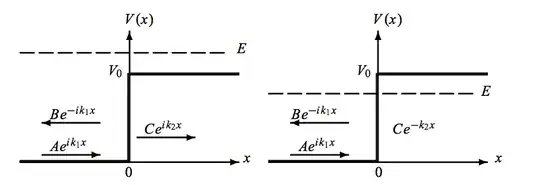For the first case where $E>V_0$ the explanations of user35736 should have clarified things for you. Just bear in mind that solutions of type $e^{ikx}$ in general are trigonometric solutions (oscillatory) and by no means are they exponentially decaying or amplifying, so no problems there. Now I will elaborate on the 2nd case.
First thing you should realise is that $E$ is the total energy of your system. So clearly in the second case when $E<V_0$ the potential is greater than the total energy, such cases we denote as classically forbidden regions, because from a purely classical point of view, the system has 0 chance of being in a state where its potential energy is larger than its total energy or in other words having a negative kinetic energy, unless the system is perturbed somehow of course.
Now in quantum mechanics, the system has a non-zero probability of being transmitted to the classically forbidden regions, in other words the wave function $\psi(x)$ leaks partially into $E<V_0$ region and is partially reflected towards $x<0$ where it undergoes a phase change. But physically we know that the system cannot have a exponentially diverging probability amplitude in the forbidden regions, instead we only look for solution which are rather exponentially decaying, $De^{k'_2x}\rightarrow 0$ and keep the decaying part $Ce^{-k'_2x}.$
From a purely mathematical point of view, wavefunctions that blow up exponentially are not members of our Hilbert space, only those square-integrable ones can be.
Long story short in the case of $E<V_0$ classically one expects the particle to be reflected at $x=0$ and never to get to region $x>0.$ This is not the same in QM, as we find solutions for region $x>0$ as well, $$
\begin{align*}
\psi_{\rm x>0} = & Ce^{-k'_2x} \\
k'_2=& \left(\frac{2m|E-V_0|}{\hbar^2}\right)^{1/2}
\end{align*}
$$
and again the growing exponential part $e^{k'_2x}$ does not belong to the physical Hilbert space and must vanish. But all this means that we nevertheless have a finite probability for finding the particle in the region where its kinetic energy $E-V_0$ is negative. The fact that the particle can penetrate into the classically forbidden regions leads to the phenomenon called tunneling, and the point at which the transition occurs (from one region to another) is called a turning point.

